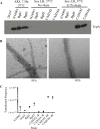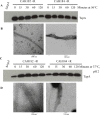Production of putative enhanced oral cholera vaccine strains that express toxin-coregulated pilus
- PMID: 28384206
- PMCID: PMC5383245
- DOI: 10.1371/journal.pone.0175170
Production of putative enhanced oral cholera vaccine strains that express toxin-coregulated pilus
Abstract
The use of whole cell killed (WCK) oral cholera vaccines is an important strategy for cholera prevention in endemic areas. To overcome current vaccine limitations, we engineered strains of V. cholerae to be non-toxigenic and to express the protective protein colonization factor, toxin-coregulated pilus (TCP), under scale-up conditions potentially amenable to vaccine production. Two V. cholerae clinical strains were selected and their cholera toxin genes deleted. The tcp operon was placed under control of a rhamnose-inducible promoter. Production and stability of TCP were assessed under various conditions. The strains lack detectable cholera toxin production. The addition of 0.1% rhamnose to the growth medium induced robust production of TCP and TcpA antigen. The strains produced intact TCP in larger growth volumes (1 L), and pili appeared stable during heat-killing or acid treatment of the bacterial cultures. To date, no WCK cholera vaccines have included TCP. We have constructed putative strains of V. cholerae for use in a vaccine that produce high levels of stable TCP antigen, which has not previously been achieved.
Conflict of interest statement
Figures





Similar articles
-
Inactivated Vibrio cholerae Strains That Express TcpA via the toxT-139F Allele Induce Antibody Responses against TcpA.J Microbiol Biotechnol. 2022 Nov 28;32(11):1396-1405. doi: 10.4014/jmb.2209.09001. Epub 2022 Oct 12. J Microbiol Biotechnol. 2022. PMID: 36317425 Free PMC article.
-
A Vibrio cholerae classical TcpA amino acid sequence induces protective antibody that binds an area hypothesized to be important for toxin-coregulated pilus structure.Infect Immun. 2004 Oct;72(10):6050-60. doi: 10.1128/IAI.72.10.6050-6060.2004. Infect Immun. 2004. PMID: 15385509 Free PMC article.
-
Pathogenic and vaccine significance of toxin-coregulated pili of Vibrio cholerae E1 Tor.J Biotechnol. 1999 Aug 20;73(2-3):109-17. doi: 10.1016/s0168-1656(99)00114-5. J Biotechnol. 1999. PMID: 10486921 Review.
-
Clinical and environmental isolates of Vibrio cholerae serogroup O141 carry the CTX phage and the genes encoding the toxin-coregulated pili.J Clin Microbiol. 2001 Nov;39(11):4086-92. doi: 10.1128/JCM.39.11.4086-4092.2001. J Clin Microbiol. 2001. PMID: 11682534 Free PMC article.
-
Safe, live Vibrio cholerae vaccines?Vaccine. 1988 Apr;6(2):151-4. doi: 10.1016/s0264-410x(88)80019-7. Vaccine. 1988. PMID: 2898843 Review.
Cited by
-
Immunomodulatory effects of mesenchymal stem cell-conditioned media on lipopolysaccharide of Vibrio cholerae as a vaccine candidate.Stem Cell Res Ther. 2021 Nov 3;12(1):564. doi: 10.1186/s13287-021-02622-0. Stem Cell Res Ther. 2021. PMID: 34732259 Free PMC article.
-
Inactivated Vibrio cholerae Strains That Express TcpA via the toxT-139F Allele Induce Antibody Responses against TcpA.J Microbiol Biotechnol. 2022 Nov 28;32(11):1396-1405. doi: 10.4014/jmb.2209.09001. Epub 2022 Oct 12. J Microbiol Biotechnol. 2022. PMID: 36317425 Free PMC article.
-
Recombinant Globular Domain of TcpA Pilin from Vibrio cholerae El Tor: Recovery from Inclusion Bodies and Structural Characterization.Life (Basel). 2022 Nov 7;12(11):1802. doi: 10.3390/life12111802. Life (Basel). 2022. PMID: 36362959 Free PMC article.
-
Vibrio cholerae, classification, pathogenesis, immune response, and trends in vaccine development.Front Med (Lausanne). 2023 May 5;10:1155751. doi: 10.3389/fmed.2023.1155751. eCollection 2023. Front Med (Lausanne). 2023. PMID: 37215733 Free PMC article. Review.
References
-
- Ali M, Lopez AL, You YA, Kim YE, Sah B, Maskery B, et al. The global burden of cholera. Bulletin of the World Health Organization. 2012;90(3):209–18a. Epub 2012/03/31. PubMed Central PMCID: PMCPmc3314202. doi: 10.2471/BLT.11.093427 - DOI - PMC - PubMed
-
- Bishop AL, Camilli A. Vibrio cholerae: lessons for mucosal vaccine design. Expert Rev Vaccines. 2011;10(1):79–94. PubMed Central PMCID: PMCPMC3036168. doi: 10.1586/erv.10.150 - DOI - PMC - PubMed
-
- Baik YO, Choi SK, Olveda RM, Espos RA, Ligsay AD, Montellano MB, et al. A randomized, non-inferiority trial comparing two bivalent killed, whole cell, oral cholera vaccines (Euvichol vs Shanchol) in the Philippines. Vaccine. 2015;33(46):6360–5. doi: 10.1016/j.vaccine.2015.08.075 - DOI - PubMed
-
- WHO. Cholera. World Health Organization, 2015.
MeSH terms
Substances
Grants and funding
LinkOut - more resources
Full Text Sources
Other Literature Sources

